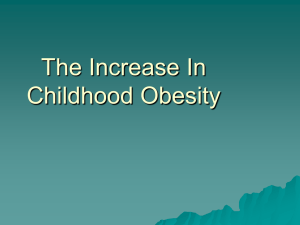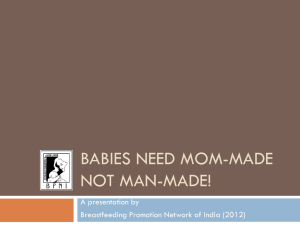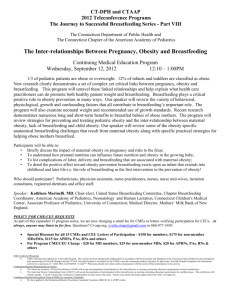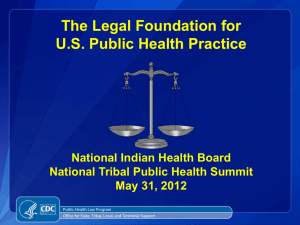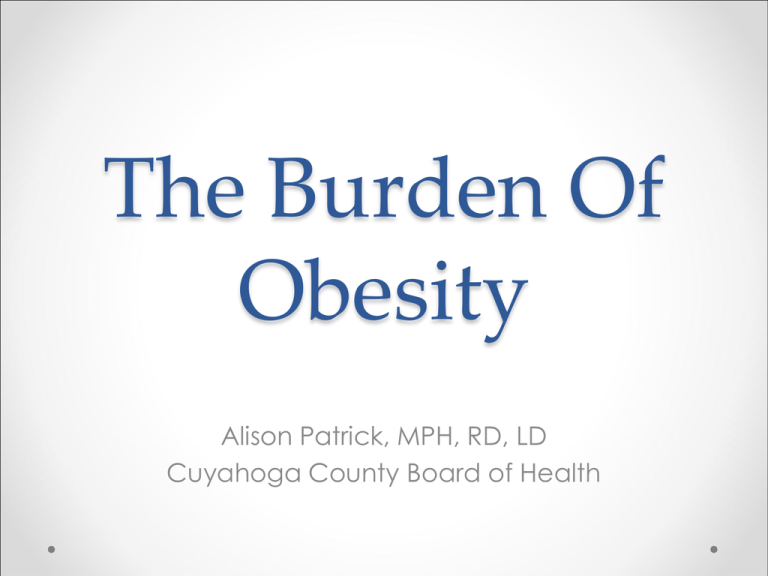
The Burden Of
Obesity
Alison Patrick, MPH, RD, LD
Cuyahoga County Board of Health
For the first time in
two centuries, the
current generation
of children in
America may live
shorter lives than
their parents.
Childhood Obesity - Defined
• Calculated using a child’s weight and height
o Weigh status is then determined using age and sex specific
percentile for BMI rather than using the adult BMI
categories
• Childhood overweight: At or above the 85th
percentile and lower than the 95th percentile for
children of the same age and sex
• Childhood obesity: At or above the 95th percentile
for children of the same age and sex
Childhood Obesity:
The Good News
• Nationally, the percentage of American children
who are obese has not increased in the past
decade
Childhood Obesity:
The Bad News
• There has been no decrease in the percentage of
American children who are obese
Childhood Obesity: Disparities
Early Childhood Obesity
• 10% of infants and toddlers have high weight-forlength
• 1 in 7 low-income preschool-aged children is obese
2009-2011 County Obesity Prevalence
Among Low-Income Children Aged 2 to 4 Years
Chronic Disease Implications
•
Children who are obese are more than twice as likely to die before
the age of 55
•
70% of obese youth have at least one risk factor for cardiovascular
disease
o 39% of obese children have two or more risk factors
•
Children who are obese after the age of 6 are 50% more likely to be
obese as adults
•
Chronic disease accounts for 75% of health care spending in the US
2012 F as in Fat Report
Trust for America’s Health
Economic Cost of Obesity
• Obesity related medical care
o $160 billion per year (2010 estimate)
• Indirect cost of obesity in America
o $450 billion per year (2011 estimate)
• $140 billion on incremental food costs, plus-sized clothing, and weight
loss products and programs
• $160 billion on medications, surgeries, and doctor visits
• $130 billion on absenteeism, decreased productivity, and short-term
disability
• $20 billion on increase use of fuel, electricity, etc.
OHIO: Obesity (BMI>95%tile)
Across the Lifespan
2-5 yr. olds
<5%
5-9.9%
10-17 yr. olds
10-14.9%
15-19.9%
Adults
20-24.9%
Pediatric Nutrition Surveillance System (PedNSS), CDC, and ODH 2006
Ohio Family Health Survey (OFHS), ODJFS/ODH/ODI/ODMH, 2008
25-29.9%
>30%
Does Place Matter?
Where you live, work, pray, and
play impact our health
Fact
The choices we make are
shaped by the choices we
have
Prevalence of obesity in Cleveland neighborhoods, 2005-2009
Source: Behavioral Risk Factor Surveillance System (BRFSS)
Cleveland neighborhood clusters
(W) West Riverside, Puritas-Longmead, Kamms Corner, and Jefferson
(NW) Northwest Edgewater, Cudell, Detroit-Shoreway, Ohio City/Near
West Side, and
Tremont
(S/SW) South/
Southwest:
West Boulevard, Stockyards, Clark-Fulton, Brooklyn-Center, and Old
Brooklyn
(E) East: Downtown, Central, Goodrich-Kirtland Park, St. ClairSuperior, Fairfax, Hough, and University
(NE) Northeast: Glenville, Forest Hills, North and South Collinwood,
and Euclid-Green
(EC) Eastern
Corridor:
Industrial Valley, North Broadway, Kinsman,
Woodland Hills and Buckeye-Shaker
(SE) Southeast: South Broadway, Union-Miles, Corlett,
Mt. Pleasant, and Lee-Miles
Lyndhurst 88.5
Hough 64.0
Life Expectancy: 80.3
High School grads: 98.1%
Unemployment: 3.4%
Poverty: 3.3%
Home ownership: 92.6%
Non-white: 22.90%
Life Expectancy: 74.5
High School grads: 82.9%
Unemployment: 9.2%
Poverty: 17.2%
Home ownership: 56.3%
Non-white: 46.1%
Life Expectancy: 65
High School grads: 68.2%
Unemployment: 18.7%
Poverty: 37.4%
Home ownership: 33.60%
Non-white: 95.4%
Cuyahoga County
Youth Risk Behavior Survey
• 2011 High School Survey
o 12,749 student responses
• Nutrition
o
o
o
o
22.6% of students met the recommendation for fruit and vegetable intake
22.8% of students are drinking at least one soda per day
Only 32.7% of students eat breakfast daily
75% of students report eating fast food one day per week
Youth Risk Behavior Survey
• Physical Activity
o Only 43.8% of students met the recommended levels of physical activity
o 34.3% of students watch three of more hours of television daily
o 27.2% of students play video games three or more hours daily
• Weight Status
o 16.6% of students are overweight
o 13.3% of students are obese
Early Childhood Obesity:
Taking Action
A Policy Approach
• All children have these things in common:
o The need for healthy food options
o The need for adequate time for physical activity
o Health and child care providers that monitor
health and growth, are mindful of healthy
patterns, and can advise and assist parents in
addressing issues
A Policy Approach
• Goal: To establish policies that are not only
universal in addressing the health of young children,
but that are also feasible across different settings
and account for the potential negative social and
economic factors that exist in communities
Breastfeeding Policy
• Adults working with infants and families should
promote and support exclusive breastfeeding for 6
months, and continuation of breastfeeding through
one year of age, along with the introduction of age
appropriate foods
10 Steps to BreastfeedingFriendly Child Care Centers
•
•
•
•
•
•
•
•
•
•
Designate an individual or group who is responsible for development and
implementation of the ten steps.
Establish a supportive breastfeeding policy and require all staff be aware of and follow
the policy.
Establish a supportive worksite policy for staff members who are breastfeeding.
Train all staff so that they are able to carry out breastfeeding promotion and support
activities.
Create a culturally appropriate breastfeeding-friendly environment.
Inform expectant and new families and visitors about your center’s breastfeeding-friendly
policies.
Stimulate participatory learning experiences with the children, related to breastfeeding.
Provide a comfortable place for mothers to breastfeed or pump their milk in privacy, if
desired.
Educate families and staff that a mother may breastfeed her child wherever they have a
legal right to be. Establish and maintain connections with local breastfeeding coalition or
community breastfeeding resources.
Maintain an updated resource file of community breastfeeding services and resources
kept in an accessible area for families
Nutrition Policy
• Require that all meals, snacks, and beverages
served be consistent with the USDA Child and Adult
Food Care program meal patterns
o Pattern is consistent with the Dietary Guidelines for Americans
• Ensure safe drinking water be both available and
accessible to children
Nutrition Policy –
Food Access
• Promote and refer individuals to food assistance
programs
o Promote use of farmers market incentive
programs
• Farm to Preschool
• School Gardening
Energy Dense Foods and Sugar Sweetened Beverages
• Limit or eliminate consumption during day
• Avoid use as reward in classroom
o Limit use and consumption for classroom parties
• Fundraisers
Physical Activity
• Establish physical activity policy to ensure infants,
toddlers, and preschool children have opportunities
for physical activity throughout the day
• Policy should also ensure that the facility built
environment supports the promotion of physical
activity
• Policy should also support professional
development opportunities for staff related to
physical activity
Physical Activity Policy
• Opportunities to move freely
o Withholding physical activity should not be used as a
punishment
• Infants, toddlers, and preschoolers should be
allowed to move freely
o Policy needs to limit the use of equipment that restricts
movement
• Infant equipment should be used only for its intended
purpose
Screen Time Policy
• Limit screen time for ages 2-5
o Less than 30 minutes per day for children in half-day
programs
o Less than 1 hour per day for children in full-day programs
Questions?
Alison Patrick, MPH, RD, LD
apatrick@ccbh.net
216-201-2001 x 1513




